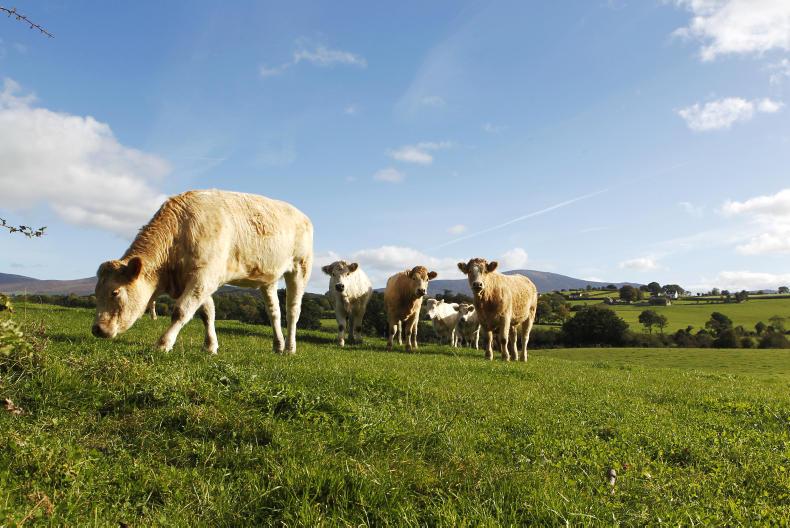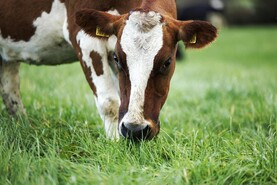On drier land, farmers have managed to get some cattle out to grass. Ground conditions have also improved on heavier land, allowing some farmers to finally get some fertiliser and slurry on to ground.
Where cattle have just been turned out to grass this week, here are five management tips for the week ahead.
1 Be on the lookout for tetany
If cows are grazing paddocks that received potash, either in the form of chemical fertiliser or slurry, be on the lookout for grass tetany, especially with warm days and cold nights.
Make sure cows have magnesium lick buckets, add magnesium to drinking troughs or give cows a mineral bolus to reduce the risk. As a rule of thumb, provide one lick bucket for every 10 cows.
2 Smaller grazing areas
Rather than giving smaller groups of cattle a full paddock to graze, split the paddock into two or three divisions to increase grass utilisation.
This will prevent cattle from spoiling grass and ensure a good clean-out to the sward base, increasing grass quality in the next rotation.

3 Keep cattle moving
Keep cattle groups moving every day, or every second day, to prevent any ground damage from occurring.
Working with a smaller paddock and moving cattle to fresh grass every day will help to keep them settled.
There is some rain forecast later this week, so moving cattle at the same time every day will help to keep them settled.
Do not let cattle go hungry, as they will become unsettled when wet and may poach ground. Offer some meals if necessary.
4 Keep paddocks square
Where possible, try to keep paddocks as square as possible. This will reduce the amount of walking cattle will do if they become unsettled. Make use of temporary electric wire to control paddock shape and size.
5 Do not be afraid to rehouse cattle
If there is rain later this week and ground becomes wet, do not be afraid to rehouse stock. There is no shame in bringing cattle in. You can put cattle back out again once conditions improve.
Read more
Switching from continental to traditional beef breeds
EU beef production still on the rise for 2017
Beef management notes: grazing
On drier land, farmers have managed to get some cattle out to grass. Ground conditions have also improved on heavier land, allowing some farmers to finally get some fertiliser and slurry on to ground.
Where cattle have just been turned out to grass this week, here are five management tips for the week ahead.
1 Be on the lookout for tetany
If cows are grazing paddocks that received potash, either in the form of chemical fertiliser or slurry, be on the lookout for grass tetany, especially with warm days and cold nights.
Make sure cows have magnesium lick buckets, add magnesium to drinking troughs or give cows a mineral bolus to reduce the risk. As a rule of thumb, provide one lick bucket for every 10 cows.
2 Smaller grazing areas
Rather than giving smaller groups of cattle a full paddock to graze, split the paddock into two or three divisions to increase grass utilisation.
This will prevent cattle from spoiling grass and ensure a good clean-out to the sward base, increasing grass quality in the next rotation.

3 Keep cattle moving
Keep cattle groups moving every day, or every second day, to prevent any ground damage from occurring.
Working with a smaller paddock and moving cattle to fresh grass every day will help to keep them settled.
There is some rain forecast later this week, so moving cattle at the same time every day will help to keep them settled.
Do not let cattle go hungry, as they will become unsettled when wet and may poach ground. Offer some meals if necessary.
4 Keep paddocks square
Where possible, try to keep paddocks as square as possible. This will reduce the amount of walking cattle will do if they become unsettled. Make use of temporary electric wire to control paddock shape and size.
5 Do not be afraid to rehouse cattle
If there is rain later this week and ground becomes wet, do not be afraid to rehouse stock. There is no shame in bringing cattle in. You can put cattle back out again once conditions improve.
Read more
Switching from continental to traditional beef breeds
EU beef production still on the rise for 2017
Beef management notes: grazing







 This is a subscriber-only article
This is a subscriber-only article










SHARING OPTIONS: